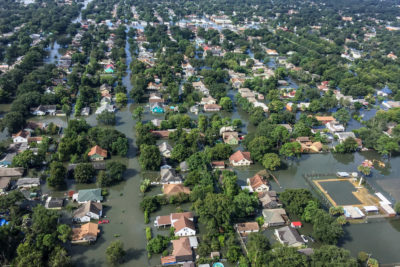Flooding on the outskirts of Houston after Hurricane Harvey, August 31, 2017. U.S. Army National Guard
If not for climate change, 2017’s Hurricane Harvey might have flooded half as many homes in the Houston area, a new study finds.
“We already know that climate change is increasing the severity and frequency of extreme weather events,” Kevin Smiley, a sociologist at Louisiana State University and lead author of the study, said in a statement. “But now researchers are able to pinpoint the extent of damage from a specific extreme weather event such as Hurricane Harvey and the resulting floods.”
Warmer air holds more moisture, leading to heavier downpours. Previous estimates suggest that climate change increased Hurricane Harvey’s rainfall total by 15 to 38 percent. When Harvey hit Harris County, Texas five years ago this month, it flooded around 100,000 homes. But without climate change, the study found, some 30,000 to 50,000 homes might have been spared, avoiding billions of dollars of residential damage.
“Climate change is happening right now with real and substantial costs,” Smiley said. “Three to five extra inches of rainfall from climate change can make the difference between your lawn getting soaked and your house getting flooded leaving it uninhabitable.”
Flooding from Hurricane Harvey by racial or ethnic group in scenario where climate change made rainfall 38 percent more severe. Smiley et al.
For the study, scientists used computer models to compare the extent of damage with and without climate change. In a world shaped by higher temperatures, flooding was far more pervasive and disproportionately affected Hispanic residents. Hispanic households accounted for roughly half of the homes flooded as a result of climate change in the scenario where warming had the greatest impact, while white households accounted for only around a third, according to the study. The findings were published in the journal Nature Communications.
“Part of the reason why low-income neighborhoods flooded has to do with the historical development of Houston along its waterways and surrounding petrochemical corridor,” Smiley said. “There’s a clear climate and environmental justice story as to where these neighborhoods are located.”
ALSO ON YALE E360
Unequal Impact: Putting Justice at the Heart of the Climate Fight




